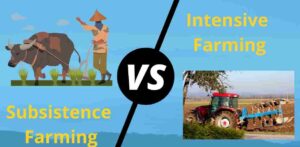Farming is the process of growing crops, livestock, aquatic organisms and poultry birds to fulfil the hunger demand of the world. During primitive times, there were traditional methods of farming that gradually improved to subsistence, intensive and sustainable farming.

As society progresses, Capitalism emerges which creates marketing opportunities and any product can be sold at a high price. So, People start to sell their products. Their profit depends upon the amount of food they produce. When the green revolution occurred, the high use of Fertilizers, Pesticides, and HYV increased which ultimately led to intensive farming.
In this article, we will be learning about the key differences between subsistence farming and intensive farming with some examples to make our concept very clear.
Distinguish Between Subsistence Farming And Intensive Farming
Here, We have listed the 10 key differences between subsistence farming and intensive farming in detail:-
1. Definition And Example
➡️Subsistence farming is the process of growing crops and rearing livestock without much use of input (Land, Labour and Capital) to produce an output that meets the needs of the family. In simple terms, It is like solving a hand to mouth problem. Tony Waters designates these farmers as “Subsistence Peasants”
For Example: We have a field of 20 square metres. According to recommended seed rate of maize, we can grow 40 maize by maintaining the recommended spacing of 5*5. It is all normal sowing.
If you grow vegetables on the rooftop and manage regular requirements without buying from the market. Then it is also Subsistence farming.
➡️Intensive farming is the process of growing crops and rearing livestock by using large amounts of input (Land, Labour and Capital) to produce a maximum output that can be sold in the market to earn money. For Example: Growing 40 same maize in the same area by reducing spacing to 2*2 by heavy use of input.
2. Type Of Farming
➡️Subsistence farming is an organic approach. There is no overexploitation of land, no use of pesticides and fertilizers. People use FYM, Compost to improve the fertility of the soil. It is like eating whatever mother nature gives you in return for your work. So, The product is best suited for our good health.
➡️Intensive farming as the name indicates uses an Intense amount of Fertilizers, Pesticides, Chemicals and Heavy equipment to produce the most out of the given land. It isn’t good for our health.
3. Production
There is no surplus production in Subsistence farming. There is no selling of food in the market to earn money. It is simple farming. Even if the surplus is produced, It is stored until the next harvest.
The main motive here is to produce as much as we can from the particular area so that surplus food can be sold in the market to make a decent profit. It is a business.
4. Location
➡️A person can do subsistence farming in his backyard, kitchen garden or any land that fulfils his family needs.
➡️A person can do Intensive farming in a larger area where he can generate maximum output.
5. Varietal Use
➡️Subsistence farmers use local cultivars. They don’t use hybrid and improved varieties. They sow seeds from the previous harvest. In livestock also, Local breeds are used.
➡️Intensive farmers use Improved varieties, Dwarf Varieties, HYVs that give a maximum return in less area and less time. It tries to take two harvests in one year from the same land by planting early maturing varieties. In livestock, Cross Breed and improved breeds are reared.
6. Farmers Involved
➡️Marginal and Poor farmers can’t go intensive farming due to high investment costs. However, They can do it if they manage a decent amount of Land, Labour and Capital.
➡️Big farm owners and rich farmers are more into intensive farming as they can manage all the necessary input in abundant amounts.
7. Inputs
➡️Subsistence farming uses household labour, own land and own capital which is less.
➡️Intensive farming uses skilled labour, large land (Lease or own) and large amounts of capital.
8. Tools Used
➡️Traditional tools are used which are operated manually. Therefore, It is hard work. Tools like Spade, Sickle.
➡️Modern and advanced tools and machinery are used which makes the agricultural work way faster.
9. Crops Type
➡️In general, Foodgrain, vegetables and fruits are grown. Crops are grown according to the season.
➡️Cash crops like cotton, tea, coffee and cereal are grown. Off Seasonal crops are also grown.
10. Irrigation
➡️Subsistence farming doesn’t have an irrigation channel. It depends on Monsoon rain and irrigation by a family member.
➡️Intensive farming has a well-improved irrigation channel that provides the water needed for crops in the field.
